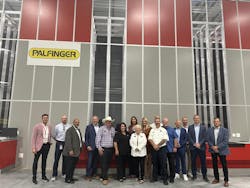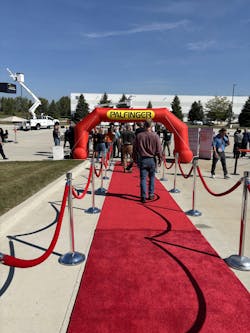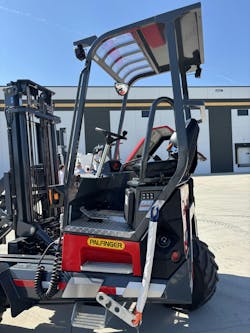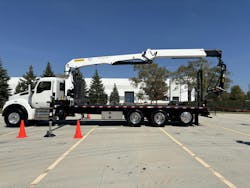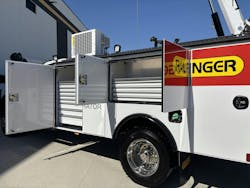Maintenance Mindset: Action Park at PALIFINGER'S new parts distribution facility
Key Highlights
- PALFINGER's Midwestern facility was built in just four months, thanks to strong local support.
- The event featured an Action Park with demonstrations of advanced equipment, including truck-mounted forklifts, material handling cranes, and mechanics trucks with service cranes.
- The community was a key factor in choosing the strategic location in the Chicago metropolian area.
- Local officials and PALFINGER leadership emphasized collaboration and service excellence in the partnership.
In September, I attended a grand opening event at PALFINGER for its new parts distribution center in Huntley, IL, which happened to be very close to where I live. Huntley is a growing town, about 28,500 people. Compared to what Huntley was when I was a kid, it’s now a behemoth of shopping, recreation, and industry, but outside of this area’s towns and villages is still largely rural and corn fields. Some might consider this area outside of what we would typically consider the suburbs of Chicago, but definitely part of the Chicago metropolitan area or Chicagoland, as location was prime for this advanced facility.
The appreciation for Midwestern hospitality was also on full display at the grand opening event. I was struck by how often the village of Huntley was mentioned in the celebration for the facility with a true appreciation for the community feel and welcome. PALFINGER, which is based in Germany, was very happy to be in Huntley.
At the ribbon cutting ceremony, CEO Andreas Klauser, credited Huntley Mayor Tim Hoerst and the local team for helping to manage the project quickly, as the entire facility and its AutoStore, a robotic pick-and-place container system for parts distribution, was built in four months.
“We feel very much appreciated. It’s not only about the numbers. It’s not only about the figures. PALFINGER, we feel very much appreciated here by the city of Huntley, and this is also something which is not always the case. When you want to establish something, there are more questions than answers, so keep this service up, and this leads back to what is expected here from this parts operation in Huntley is to serve our customers, to satisfy our customers. So we learned a lot about service here from the local community, and we need to reflect this in our entire growth plan for PALFINGER North America.”
PALFINGER looked at a number of facilities in the northern Illinois, Chicagoland area, and part of the decision came down to the local community. “What we found is that the location here, both with the county and the regulations, and also more importantly, within the village, their ability to work with us was a key factor in making the determination that we would build it out here in Huntley,” said Dave Larson, consultant for PALFINGER.
Action Park: Demos for truck-mounted forklifts, material handling cranes and mechanics trucks with service crane
Outside the red carpet grand opening event, PALFINGER had great food and an Action Park, where I spent some time talking with product managers about some of the company’s best working vehicles. And if you make it all the way to the final video, you’ll get to see me operating a mechanics truck service crane. It’s somewhat like the giant claw machine that we fed quarters as a kid to win stuffed animals. I needed my little brother. He was way better at that game than me and would have to win stuffed animals for me. But I roughed the brutal heat that day and gave it a try!
I spoke with Jason Gaydos, the PALFINGER product manager for North America for truck mounted forklifts, and part of his job is overseeing the marketplace for the latest trends and safety innovations. “We’re always trying to stay a step ahead, to make sure that, first and foremost, the operators are always safe in what they do. We want them to come home every day.”
In 2022, PALFINGER reintroduced the truck-mounted forklift product line, which are off-road machines used on rough terrain. “We went out and we surveyed the market with the technicians and the operators and owners and fleet managers,” Gaydos said. “What can we do for you to make your job easier, more efficient, more effective, minimize damaged products and loads and obviously? As I said, how can we make sure that your operators are safe and coming home less stressed and fatigued?”
He showed me the newest design—the FHS 55— side seat 5,500-pound capacity truck-mounted forklift. “We focused it essentially around the operator and the technician,” Gaydos said.
“The big thing for operators in the field that we found is that your traditional truck-mounted forklift, when hanging on the back of a truck, would always require the operator to overextend themselves to climb up and down. So we were one of the first in the market to include control ground switches, and this allows the operator to stand on the ground and mount and dismount the forklift off the back of the transport truck,” he added. The number one insurance claim for truck mounted forklift owners is slip and fall from climbing up and down, and it can be especially dangerous in winter conditions.
The new design also has more room for the operator to get in and out of the cabin. “Our seat, which opens 25 degrees outwards, allows the operator to have a nice, clean egress and ingress, and then the floorboard is unobstructed,” Gaydos said.
The product line was also designed with modularity in mind. “We actually adopted an automotive foresight, and we use a modular frame. So basically, one frame with a quick couple of adjustments can be utilized across seven different models,” Gaydos said. Instead of building seven different machines, the base of all the mechanics for the frame, the engine, the hydraulics, and the electronics are all linear across the board, and each machine changes the configuration.
The cabin has side operator guardrail protection that swivels with the seat, and the ergonomics of the seat was also designed with operation in mind. The seat turns five degrees inward to minimize operator fatigue from turning over their shoulder when backing up. “So just that little bit, just meant the world to the operators,” Gaydos said.
When asked, the forklift technicians wanted (no surprise) ease of access when working on the vehicles. “They want to show up on a machine and instantly start servicing it. It's a quicker maintenance schedule and quicker repairs. And it's minimal downtime, and that was very big to our technicians out there,” he added. Under one hood, technicians can access the battery, air filter, fuel filter, oil filter, and hydraulic filter.
PALFINGER plans to release two more heavier capacity machines in the fourth quarter. The prototypes are out in the field, where they undergo a year of testing. “We go out and we put the in the environments, and we try to literally break them and make sure that they hold up before we put our name on the back of it,” Gaydos said.
I also saw the PW 42001 SH material handling crane, which features four hydraulic extensions for a total reach of 61 feet. Greg Sneek, cranes product manager at PALFINGER, noted the innovative turntable bearing system, which gives operators working in high angles or city streets, the power to lift the load and rotate the full load onto where they’re intending to deliver it.
The finish on the crane is also unique. Anything black on the crane is finished in a process called KTL. “It's a paint process that is a dip process, so all parts are electrically bonded inside and out throughout the whole crane, and that provides us with superior rust protection on the crane.” Sneek said.
Material handling cranes have changed significantly from a generation ago, he added. Traditionally, cranes had a top seat, where the operator would be seated. Now, the crane is operated remotely from the ground. A crew of two can operate the crane, where the operator can assist with unloading pallets when not operating the crane.
Clint Weckwerth, product manager of service cranes and crane bodies at PALFINGER, discussed the PAL Pro line of mechanics trucks for field mechanics, and on-site I saw (and operated) the PAL Pro 43 with the PALFINGER Service Crane (PSC) 8029.
The truck’s side compartments are customizable with tool drawer units, chains, shelves, and hooks. The driver’s side or street side compartments of this demonstration truck were configured for emergency technology, but it can be configured for any size and number of doors that fit the space. A unique newly added feature includes lights along the top rack, not to illuminate the area or the ground, but what’s inside the compartments for easier access. The back of the truck, called the tail shelf workbench includes a standard vice but that can also be customized. The 2026 truck version will include an aluminum back panel, instead of steel, making the addition of lights much easier without worry about rust.
The crane’s pistol grip remote control that I operated below is a trigger toggle, but it can be made with a dual joystick arrangement. “The remote has load moment indication (LMI), so it’s going to tell you the amount of weight that you’re picking up at the current time and then it’s going to calculate based off of that, how much more can you actually lift or how far out can you extend it. It’ll tell you what percent of your max capacity you’re at in real-time,” Weckwerth said.
About the Author

Anna Townshend
managing editor
Anna Townshend has been a journalist and editor for almost 20 years. She joined Control Design and Plant Services as managing editor in June 2020. Previously, for more than 10 years, she was the editor of Marina Dock Age and International Dredging Review. In addition to writing and editing thousands of articles in her career, she has been an active speaker on industry panels and presentations, as well as host for the Tool Belt and Control Intelligence podcasts. Email her at [email protected].
